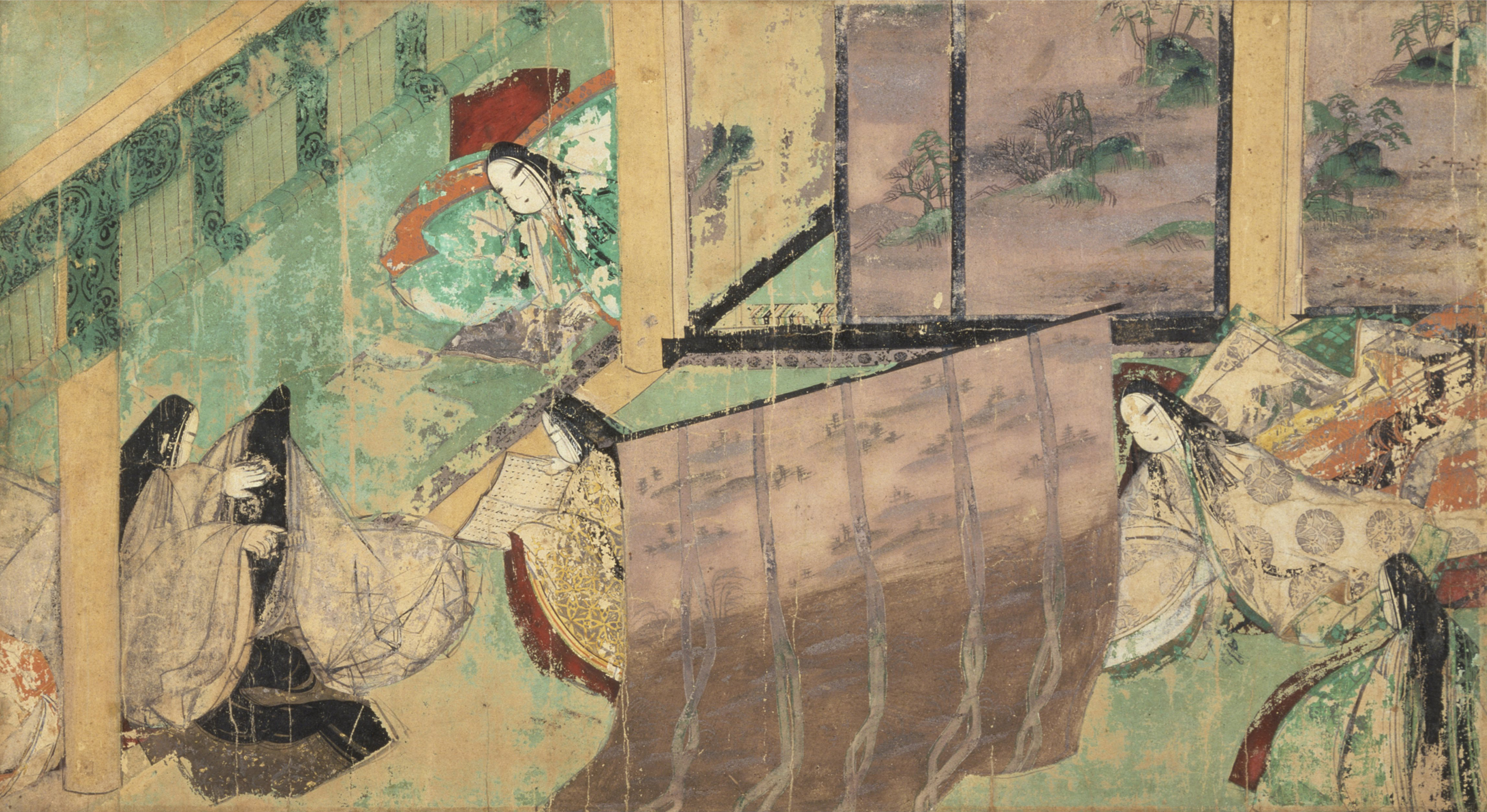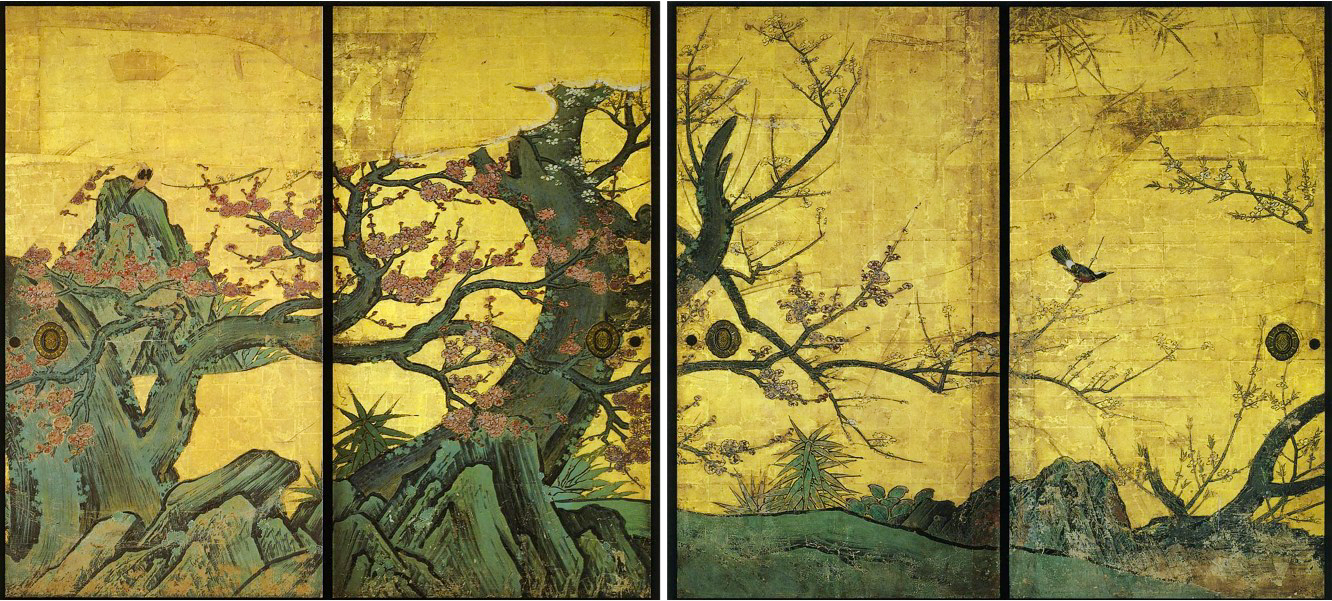|
Yamato-e
is a style of Japanese painting inspired by Tang dynasty paintings and fully developed by the late Heian period. It is considered the classical Japanese style. From the Muromachi period (15th century), the term Yamato-e has been used to distinguish work from contemporary Chinese-style paintings , which were inspired by Chinese Song and Yuan-era ink wash paintings. Characteristic features of Yamato-e include many small figures and careful depictions of details of buildings and other objects, the selection of only some elements of a scene to be fully depicted, the rest either being ignored or covered by a "floating cloud", an oblique view from above showing interiors of buildings as though through a cutaway roof, and very stylised depiction of landscape. Yamato-e very often depict narrative stories, with or without accompanying text, but also show the beauty of nature, with famous places or the four seasons . The pictures are often on scrolls that can be hung on a wall (), hand ... [...More Info...] [...Related Items...] OR: [Wikipedia] [Google] [Baidu] |
Ukiyo-e
Ukiyo-e is a genre of Japanese art which flourished from the 17th through 19th centuries. Its artists produced woodblock prints and paintings Painting is the practice of applying paint, pigment, color or other medium to a solid surface (called the "matrix" or "support"). The medium is commonly applied to the base with a brush, but other implements, such as knives, sponges, and ai ... of such subjects as female beauties; kabuki actors and sumo wrestlers; scenes from history and folk tales; travel scenes and landscapes; Flora of Japan, flora and Wildlife of Japan#Fauna, fauna; and Shunga, erotica. The term translates as "picture[s] of the floating world". In 1603, the city of Edo (Tokyo) became the seat of the ruling Tokugawa shogunate. The ''chōnin'' class (merchants, craftsmen and workers), positioned at the bottom of Four occupations, the social order, benefited the most from the city's rapid economic growth, and began to indulge in and patronise the entertainment o ... [...More Info...] [...Related Items...] OR: [Wikipedia] [Google] [Baidu] |
Emakimono
or is an illustrated horizontal narration system of painted handscrolls that dates back to Nara-period (710–794 CE) Japan. Initially copying their much older Chinese counterparts in style, during the succeeding Heian (794–1185) and Kamakura periods (1185–1333), Japanese developed their own distinct style. The term therefore refers only to Japanese painted narrative scrolls. As in the Chinese and Korean scrolls, combine calligraphy and illustrations and are painted, drawn or stamped on long rolls of paper or silk sometimes measuring several metres. The reader unwinds each scroll little by little, revealing the story as seen fit. are therefore a narrative genre similar to the book, developing romantic or epic stories, or illustrating religious texts and legends. Fully anchored in the style, these Japanese works are above all an everyday art, centered on the human being and the sensations conveyed by the artist. Although the very first 8th-century were copies of Chin ... [...More Info...] [...Related Items...] OR: [Wikipedia] [Google] [Baidu] |
Kanō School
The is one of the most famous schools of Japanese painting. The Kanō school of painting was the dominant style of painting from the late 15th century until the Meiji period which began in 1868, by which time the school had divided into many different branches. The Kanō family itself produced a string of major artists over several generations, to which large numbers of unrelated artists trained in workshops of the school can be added. Some artists married into the family and changed their names, and others were adopted. According to the historian of Japanese art Robert Treat Paine, "another family which in direct blood line produced so many men of genius ... would be hard to find". The school began by reflecting a renewed influence from Chinese painting, but developed a brightly coloured and firmly outlined style for large panels decorating the castles of the nobility which reflected distinctively Japanese traditions, while continuing to produce monochrome brush paintin ... [...More Info...] [...Related Items...] OR: [Wikipedia] [Google] [Baidu] |
Japanese Painting
is one of the oldest and most highly refined of the Japanese visual arts, encompassing a wide variety of genres and styles. As with the history of Japanese arts in general, the long history of Japanese painting exhibits synthesis and competition between native Japanese aesthetics and the adaptation of imported ideas, mainly from Chinese painting, which was especially influential at a number of points; significant Western influence only comes from the 19th century onwards, beginning at the same time as Japanese art was influencing that of the West. Areas of subject matter where Chinese influence has been repeatedly significant include Buddhist religious painting, ink-wash painting of landscapes in the Chinese literati painting tradition, calligraphy of sinograms, and the painting of animals and plants, especially birds and flowers. However, distinctively Japanese traditions have developed in all these fields. The subject matter that is widely regarded as most characteristic o ... [...More Info...] [...Related Items...] OR: [Wikipedia] [Google] [Baidu] |
Rinpa School
is one of the major historical schools of Japanese painting. It was created in 17th century Kyoto by Hon'ami Kōetsu (1558–1637) and Tawaraya Sōtatsu (d. c.1643). Roughly fifty years later, the style was consolidated by brothers Ogata Kōrin (1658–1716) and Ogata Kenzan (1663–1743). The term "Rinpa" is an abbreviation consisting of the last syllable from "Kōrin" with the word for (with rendaku changing this to "pa"), coined in the Meiji period. Previously, the style was referred to variously as the , or , or the . History Hon'ami Kōetsu founded an artistic community of craftsmen supported by wealthy merchant patrons of the Nichiren Buddhist sect at Takagamine in northeastern Kyoto in 1615. Both the affluent merchant town elite and the old Kyoto aristocratic families favored arts which followed classical traditions, and Kōetsu obliged by producing numerous works of ceramics, calligraphy and lacquerware. His collaborator, Tawaraya Sōtatsu, maintained an atelier in K ... [...More Info...] [...Related Items...] OR: [Wikipedia] [Google] [Baidu] |
Nihonga
''Nihonga'' (, "Japanese-style paintings") are Japanese paintings from about 1900 onwards that have been made in accordance with traditional Japanese artistic conventions, techniques and materials. While based on traditions over a thousand years old, the term was coined in the Meiji period of Imperial Japan, to distinguish such works from Western-style paintings or ''Yōga'' (). History The impetus for reinvigorating traditional painting by developing a more modern Japanese style came largely from many artist/educators, which included Shiokawa Bunrin, Kōno Bairei, Tomioka Tessai and art critics Okakura Tenshin and Ernest Fenollosa, who attempted to combat Meiji Japan's infatuation with Western culture by emphasizing to the Japanese the importance and beauty of native Japanese traditional arts. These two men played important roles in developing the curricula at major art schools, and actively encouraged and patronized artists. ''Nihonga'' was not simply a continuation of olde ... [...More Info...] [...Related Items...] OR: [Wikipedia] [Google] [Baidu] |
Gotoh Museum
The is a private museum in the Kaminoge district of Setagaya on the southwest periphery of Tokyo. It was opened in 1960, displaying the private collection of Keita Gotō, chairman of the Tokyu Group. Today's collection is centered on the original selection of classical Japanese and Chinese art such as paintings, writings, crafts and archaeological objects completed by a small selection of Korean arts. It features several objects designated as National Treasures or Important Cultural Properties. The exhibition changes several times per year with special openings in spring and fall. A garden with a tea house, ponds and small Buddhist statues is attached to the museum. Highlights of the Collection Genji Monogatari Emaki One of the most important items housed in the museum are sections of the oldest extant illustrated handscroll of '' The Tale of Genji'' dating to the 12th century. This Genji Monogatari Emaki used to be the property of the Hachisuka family. The fragments cover c ... [...More Info...] [...Related Items...] OR: [Wikipedia] [Google] [Baidu] |
Nagoya
is the largest city in the Chūbu region, the fourth-most populous city and third most populous urban area in Japan, with a population of 2.3million in 2020. Located on the Pacific coast in central Honshu, it is the capital and the most populous city of Aichi Prefecture, and is one of Japan's major ports along with those of Tokyo, Osaka, Kobe, Yokohama, and Chiba. It is the principal city of the Chūkyō metropolitan area, which is the third-most populous metropolitan area in Japan with a population of 10.11million in 2020. In 1610, the warlord Tokugawa Ieyasu, a retainer of Oda Nobunaga, moved the capital of Owari Province from Kiyosu to Nagoya. This period saw the renovation of Nagoya Castle. The arrival of the 20th century brought a convergence of economic factors that fueled rapid growth in Nagoya, during the Meiji Restoration, and became a major industrial hub for Japan. The traditional manufactures of timepieces, bicycles, and sewing machines were followed by th ... [...More Info...] [...Related Items...] OR: [Wikipedia] [Google] [Baidu] |
Tokugawa Art Museum
The is a private art museum, located on the former '' Ōzone Shimoyashiki'' compound in Nagoya, central Japan. Its collection contains more than 12,000 items, including swords, armor, Noh costumes and masks, lacquer furniture, Chinese and Japanese ceramics, calligraphy, and paintings from the Chinese Song and Yuan dynasties (960-1368). History Unlike many private museums in Japan, which are based on collections assembled in the modern era by corporations or entrepreneurs, the Tokugawa Art Museum houses the hereditary collection of the Owari branch of the Tokugawa clan, which ruled the Owari Domain in what is now Aichi Prefecture. The museum is operated by the Tokugawa Reimeikai Foundation, which was founded in 1931 by Yoshichika Tokugawa (1886–1976), 19th head of the Owari clan, in order to preserve the clan's priceless collection of art objects, furnishings, and heirlooms. Building architecture The architectural plan for the museum main building and southern archives were ... [...More Info...] [...Related Items...] OR: [Wikipedia] [Google] [Baidu] |
National Treasure (Japan)
Some of the National Treasures of Japan A is the most precious of Japan's Tangible Cultural Properties, as determined and designated by the Agency for Cultural Affairs (a special body of the Ministry of Education, Culture, Sports, Science and Technology). A Tangible Cultural Property is considered to be of historic or artistic value, classified either as "buildings and structures" or as "fine arts and crafts." Each National Treasure must show outstanding workmanship, a high value for world cultural history, or exceptional value for scholarship. Approximately 20% of the National Treasures are structures such as castles, Buddhist temples, Shinto shrines, or residences. The other 80% are paintings; scrolls; sutras; works of calligraphy; sculptures of wood, bronze, lacquer or stone; crafts such as pottery and lacquerware carvings; metalworks; swords and textiles; and archaeological and historical artifacts. The items span the period of ancient to early modern Japan before the ... [...More Info...] [...Related Items...] OR: [Wikipedia] [Google] [Baidu] |







